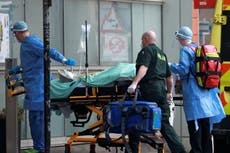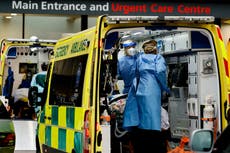How the NHS was pushed to the brink as the nation waited for lockdown
‘We’re only now seeing the start of the price we have to pay for Christmas Eve and Christmas Day mixing’, Sage member warns

As Boris Johnson addressed the nation from Downing Street on 4 January, asking them to “once again stay at home, protect the NHS and save lives”, the health service had experienced a week of escalating staff and supply crises twinned with a daily Covid caseload higher than that seen at the start of the first nationwide lockdown.
Since the start of the Christmas break hospitals across the country have reported overwhelming numbers in ICUs and patients left sitting in ambulances as they wait for bed space. Others have warned they have been unable to maintain safe staffing levels as sickness rocks the teams working to fight back the tide of the virus.
But after being criticised for moving too slowly in response to a growth in cases, and called out over last minute changes to the rules over Christmas, the government has brought in nationwide measures at a time the health service risks facing greater numbers of covid cases than during the critical early days of the nation’s outbreak.
Back in 26 March 2020, just days after the first lockdown was announced, 1,929 people were recorded as having been hospitalised with the virus across 24 hours. Peaking in April, the number would not fall below the 2,000 mark for another 20 days.
While the Department for Health has not reported new data since 22 December, the most recently available 24 hour figure stood at 2,434, part of an upward trend that saw an almost 19.7 per cent increase in admissions across a seven day period. The last time hospitalisations across 24 hours were fewer than 2,000 was the 18th.
Meanwhile the number of daily confirmed cases in the UK per 100 million has continued to grow exponentially – with an alarming chart produced by Johns Hopkins university showing the rate of infection as an almost vertical upward line over recent weeks.
Since the government last released admission statistics, hospitals have raised alarms across the UK, while NHS England figures have put the number of beds occupied by covid patients at higher than 26,000.
On New Years Day an NHS trusts in Kent reported bed occupancy levels in intensive care reaching 137 per cent – with 11 hospitals reporting they were failing to meet the number of nurses to patients required.
At the same time NHS bosses in London revealed data showing the capital is set to run out of critical care beds within a week.
Some patients in the south of England have been sent hundreds of miles away due to hospital occupancy issues, prompting the relaunching of the previously mothballed Nightingale hospital in east London to help care for those who are almost ready to leave hospital.
One clinician with knowledge of the transfers told The Independent at the time: “Staff and hospitals are overwhelmed. We have opened all our surge ICU beds and cancelled all surgery and we cannot open anymore beds. The patients in hospitals with Covid are going up and up.”
In the west midlands University Hospitals Birmingham urged doctors to help nurses with patient care tasks as well as “just ensuring they’ve had a drink / break” while warning that rising staff sickness and increasing Covid cases were seeing the number of available nurses fall below safe levels.
Meanwhile the North Middlesex University Hospital Trust warned clinicians the numbers of coronavirus patients it was treating “was putting a strain” on the oxygen system, sparking several alarms.
Last week the trust had around 200 patients on oxygen, using up 2,400 litres of the gas a minute. The trust normally uses around 1000 litres a minute and has a limit of 3,000 above which the system could cut out.
However, experts believe admission rates that have risked overwhelming hospital wards may just be the tip of the iceberg.
Sage member Professor Calum Semple said the easing of restrictions in some areas over the festive period, and the new more transmissible variant, made fresh national measures inevitable.
The University of Liverpool academic told Sky News: “We’re only now seeing the start of the price we have to pay for Christmas Eve and Christmas Day mixing.
“With that and the new variant it was inevitable we were going to have to hit a hard lockdown at this stage.”
Following the announcement of new restrictions, Dr Jeremy Farrar, director of Wellcome, said the point had been reached where a national lockdown was needed “immediately”.
He said: “Healthcare workers are working with unselfish and inspiring dedication, but the demand is overwhelming the capacity of what can be delivered by these amazing professionals.
“They must have all our support, meaning we all respect the restrictions, helping to reduce transmission of this awful virus, ultimately reducing hospitalisations and preventable deaths.”
And Dr David Strain of the University of Exeter Medical School, co-chairman of the British Medical Association’s medical academic staff committee, said: “We welcome the PM’s definitive actions to halt the rise in coronavirus and the hospitalisations that accompany it, albeit a little later than we would have liked and the science would have dictated.”
Additional reporting by agencies
Join our commenting forum
Join thought-provoking conversations, follow other Independent readers and see their replies
Comments






Bookmark popover
Removed from bookmarks